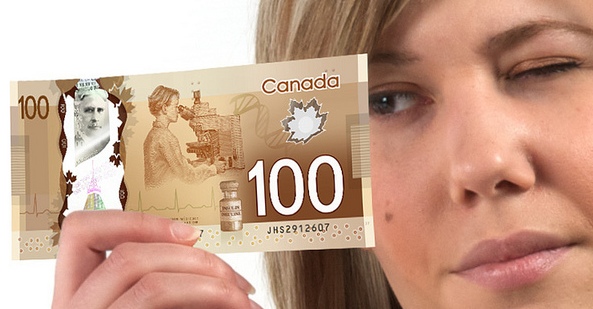Canada goes to plastic money

The Bank of Canada introduced a new series of banknotes based on plastic (polypropylene). Such banknotes are used in many countries of the world (Australia is a pioneer) because they provide much higher protection against fakes. For example, in the Canadian dollar there are transparent and translucent areas, in one of them a holographic image is hidden. It manifests itself when viewed through a translucent maple leaf at a point source of light.
For the first time in the world, plastic banknotes were issued in 1988 by the Bank of Australia ($ 10 banknotes), after which another 26 countries followed their example, including Hong Kong, New Zealand and Mexico.
They say that since 1988 there has not been a single case registered in Australia so that a fake plastic bill could pass through an automatic verification device, while the level of false positives is also close to zero. These are unreachable indicators for paper money. By the way, new Canadian bills are also made with the help of an Australian company that supplies polypropylene substrate for the production of banknotes.
')
Other security measures on Bank of Canada plastic banknotes include bulging letters, translucent text, color-changing metal engravings. For 1 min 43 sec. the video can also see the double constellation of Evrion near the lower border of the banknote. This is a repeating pattern of five Omron rings that are automatically recognized by some copier models and programs like Adobe Photoshop. This type of protection is developed by the Japanese company Omron Corporation and is protected by a patent . For the first time this pattern on euro bills was discovered in 2002 by German computer security specialist Markus Kun.
Plastic banknotes are 2.5 times more durable than paper ones (or cotton ones like US dollars), they do not get wet and do not tear. Only one minus for owners of terminals and ATMs - they will have to upgrade their devices. Worse, in fact, the firmware of the devices will have to be changed five times over the next two years, while the Bank of Canada will issue notes in circulation one by one in $ 100 (November 2011), $ 50 (March 2012), $ 10, $ 5 and $ 20 (all - in 2013).
In addition, new bills are almost twice as expensive in production: 19 cents for a plastic bill versus 10 cents for an old paper one.
By the way, the Canadian robot Canadarm2 , which operates on the International Space Station, will be depicted on the $ 5 note. Perhaps this is the first time in the history of money, when the robot hit the banknote.
Source: https://habr.com/ru/post/122820/
All Articles